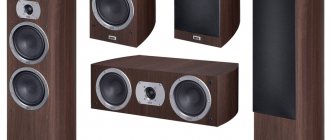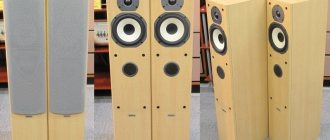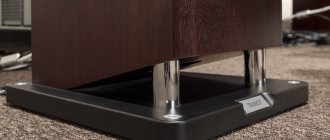Speaker systems Focal Chora 826
Focal is again creating intrigue by releasing a whole series of systems under an unfamiliar name. It seems that everything is obvious: the newly-minted Choras are aiming for the place of Chorus veterans from the affordable price segment in the lineup. However, they carry such a charge of innovation that they can easily “fire” in acoustics of a higher class. Let's take out the most powerful "guns" in the series and see who they are actually aiming at.
If you remove the Focal brand badge at the bottom from the front panel, then the new items can easily be mistaken for some Scandinavian product worthy of the most prominent IKEA display case. Their design is strikingly clean and rational, which is not very typical for the French school, which gravitates towards spectacular convex forms.
However, you can easily discern the “Focal” charm in them. Look how the bell for the tweeter is made in relief. By the way, it is special - its “bifurcation” provides a wider dispersion in the horizontal plane and a narrower one in the vertical. Beautifully rounded rings also frame the main drivers and the bass reflex port.
The French company has long brought its production to such a level of accuracy that selecting speaker sets based on the results of control measurements of the frequency response has lost its meaning
The “tower” itself stands on a wedge-shaped platform, which gives the entire structure a slope, and thus it turns out that the bass drivers are slightly extended towards the listener relative to the upper ones. And this is also one of the Focal family traits. The technology for compensating time delays due to offset, and even with adjustable directivity (called Focus Time), first appeared in the most expensive Utopia series, but was then repeated in a simplified form (Time Alignment, without adjustment) in the audiophile Sopra and Kanta. Now, as you can see, the difference in response between “light” and “heavy” drivers is taken into account even in speakers priced at 1500 euros.
A few more words about the design. We specifically removed different pairs of speakers from the boxes to show the two most impressive finishing options (there is also a third: black glossy “facades” and black cabinets with a brushed texture. You can put aside any concerns that the stereo set for test listening was made up of unpaired systems The French company has long brought its production to such a level of accuracy that selecting speaker sets based on the results of control measurements of the frequency response has lost its meaning - at the end of the day, all products are identical and fit within strict tolerances.
So-called carbon fiber-reinforced plastic (CFRP) is now used to produce load-bearing parts for the wings and fuselage of the most modern airliners.
Well, if you are confused by the deliberately simple flat walls and sharp ribs in the appearance of the Chora, then consider this another reasonable “trick” - the engineers tried to make the cases (and at the same time the base, entirely cast from plastic) as technologically advanced as possible, in order to make innovations are not cheap at all in a new development.
Let's start from the top. Underneath the perforated metal grill is a lightweight aluminum-magnesium alloy inverted dome tweeter with a Poron surround. However, this is not the second generation TNV driver familiar to us from the Chorus series, but an even more advanced TNF (used in the more expensive Aria line) with a reduced resonant frequency. In Chora 826 its range starts at 2700 Hz.
The diffusers for the mid- and low-frequency drivers are made from a material that no one has ever used in the audio industry - a thermoplastic polymer with carbon fibers. So-called carbon fiber-reinforced plastic (CFRP) is now used to produce load-bearing parts for the wings and fuselage of the most modern airliners. However, Focal engineers went further - they did not take raw materials from the nomenclature offered by CFRP suppliers, but selected their own “three-layer” formula and ensured that the concentration of internal light fibers was maximum, and their orientation in the thickness of the membrane had a special direction. This is how Slatefiber diffusers turned out - as light and stiff as woven carbon composite, but with much better internal damping.
The new material also made it possible to make a mid-frequency driver with a very low mass of the moving system, but equal in diameter (16.5 cm) to long-stroke bass drivers, which is beneficial for obtaining better consistency with the low frequencies. This driver comes in at 270Hz.
Personally, I found only one alarming point: the characteristics of the Chora 826 say that the nominal resistance is 8 ohms, but the minimum value drops below three! Of course, it would not hurt to connect the crossovers separately using a by-amping circuit to make the task easier for the output stages of the amplifiers, but Focal traditionally adheres to the simplest connection scheme. And it is precisely for this reason that we decided to listen to systems not with an AV receiver, but with an integrated circuit that can control a heavy load. But that is not all. So that the acoustics can receive the necessary current from the amplifier without any restrictions, we also stocked up on two different sets of speaker cables.
First, we connect the speakers using InAkustik LS-1603 - a 16-wire “multicore” with a serious copper cross-section. And Chora immediately disappoints with the depth of the reproduced bass. We are accustomed to the fact that manufacturers often (and without even blushing) declare a reproducible band of 25 - 30 Hz for small floor-standing systems, although in reality there is no talk of any approach to the subwoofer range. The Chora 826's datasheet lists a modest 39 Hz, but in reality it seems that they go much deeper - they give out the push of the heaviest “barrel” at a killer level without even choking! Their power at extreme lows immediately reminded them of the much more expensive floor-standing Kanta 3 or Sopra 3, which are also capable of competing with many bass machines in terms of energy.
Their power at extreme lows immediately reminded them of the much more expensive floor-standing Kanta 3 or Sopra 3, which are also capable of competing with many bass machines in terms of energy.
The interpretation of the middle is also pleasing - well-balanced, without “Kevlar” or carbon-based caustic shades. The tweeters reproduce their segment with softened dynamics, slightly emphasizing the 4-8 kHz region, which gives the overall picture not so much transparent or light, but rather saturated shades, which partly overlap the reproduced “air”. But, it seems, this is the only thing that distinguishes the new models from the same “Kant” with beryllium tweeters - the Chora is inferior to much cooler models only in the level of sound resolution, but certainly not in the overall presentation. Their sound is much more fundamental and “expensive” than that of the Chorus series. And their driving temperament is calmer than that of Aria: with a slightly convex upper bass, a slightly slowed down comfortable “punch” and a slightly compressed main midrange. The stage is more of a panoramic plan - rather wide than deep.
But don't rush to conclusions. With the InAkustik LS-1204 Air cable (small cross-section, air insulation), the interpretation changes radically! Immediately, atmosphere and volume appear, the second and third plans appear, the stereo image acquires a clear three-dimensionality precisely in depth. If the previous version could sometimes be reproached for linking some apparent images to the AS, now there is no trace of this error. The middle is saturated with microdynamic details, but the lower top, on the contrary, seems to be? no longer so persistent - the desired balance reigns in the mid/high frequency band, nuances are conveyed more weightily and frankly. Isn't this the best proof of class?
The desired balance reigns in the mid/high frequency band, nuances are conveyed more weightily and frankly. Isn't this the best evidence of high class?
Still, Chora requires a cable with minimal current loss. This is clear from the way the low range has changed with the thin “air” wire: the bass has become monotonous and has weakened in strength and clarity. It became harder for the amplifier to dampen the load, which was also reflected in increased bass resonances in the room. Even moving the acoustics to the most neutral points of the room away from the walls could not completely quiet the echoing after-sounds.
There is a very effective way out of such situations, which few people use: quasi-buy-wiring. It does not require separate connection of acoustic bands. Both cables are connected at the same terminal, forming a parallel line. If these are two identical high-quality wires, then by doubling the cross-section, we obtain such a reduction in the active resistance in the circuit, which, in correlation with the internal resistance of the amplifier’s output stages, can sometimes improve the damping factor many times over. Such a simple “tweaking” can work perfectly with different cables (but, of course, of the same length): part of the signal will “go” along a line with low inductance and with minimal losses in insulation, and the lion’s share of the current load will “leak” to the auxiliary conductor of the large cable. sections (both, by the way, do not have to be expensive).
With the Chora 826 and the Denon amplifier, this solution made it possible to raise the class of sound so much that you didn’t even want to end the listening session: the clarity and dynamics throughout the entire range increased, the “materialization” effect in the stereo scene intensified - it was this that was most captivating in almost all the programs being played.
Now you know how from a Chora bought, to put it simply, “for a hundred rubles”, you can actually get a sound “for two hundred”, which, if you are not lazy with the selection of an amplifier and cables, can jump to three hundred in terms of expressiveness.
SYSTEM
- Sources
- laptop Apple MacBook Air A1465
- Integrated amplifier/DAC Denon PMA-1600NE
- Digital cables InAkustik Referenz High Speed USB 2.0
- acoustic InAkustik Referenz Referenz LS-1603 and LS-1204 Air
- power InAkustik AC-1502 and P6
Focal Chora 826
Manufacturer: Vervent Audio Group (France)
www.focal.com/ru
Configuration: 4 emitters, 3 bands || Acoustic design: bass reflex || Frequency range: 48 - 28,000 Hz (+/-3 dB) || Lower cutoff frequency (-6 dB): 39 Hz || Sensitivity: 91 dB (2.83 V/1 m) || Resistance (nominal/minimum): 8/2.9 ohms || Crossover frequencies: 270 and 2700 Hz || Recommended amplifier power: 40 – 250 W || Finishes: Black Bezel/Grey Body, Gray Bezel/Dark Wood, Cream Bezel/Light Wood || Dimensions: 303 x 1053 x 388 mm || Weight: 21 kg || Price per pair: 109,900 .
share
Tags: FocalFocal Chora 826Good buy
FOCAL CHORUS 826 VW - TEST OF FLOOR SPEAKER SYSTEMS
The next generation of acoustics of the Chorus series with the prefix W in the name was released in honor of the 30th anniversary of Focal-JMlab (celebrated in 2008). A distinctive feature of this option was the use of the famous Focal know-how on the bass and midrange - W-sandwiches made of fiberglass, which brought well-deserved fame to the older models of the high-tech French brand.
Focal notes that the appearance of the Chorus 826 VW owes its origin to their traditional partner in the field of design - the Parisian studio Pineau & Le Porcher, which created the expressive contours for the Elec1ga and Utopia lines. The exclusive design, in particular, includes the finishing of the sides of the cases in Imperial Satin Red lacquer, again evoking associations with older models. Our particular example turned out to be decorated more restrainedly, entirely in black lacquer and with an acrylic front panel. The well-known gamma profiles of housings with non-parallel walls expanding forward are replaced here with simpler V-shapes, preserving the idea of non-parallelism and damping of standing housing resonances. The MDF walls have a thickness of 20 to 25 mm, spacers are installed inside, and the podiums for the speakers are cast aluminum. The company would be cheating on itself if it installed something other than an inverted dome on the HF. But here it is also simpler - made of aluminum-magnesium alloy (by the way, the favorite material in modern budget models of another company for which I have an invariable sympathy - JBL).
The manufacturer notes that it did not deliberately use ferromagnetic cooling fluid for the tweeter. The tweeter is mounted in a frame made of massive steel-gray aluminum in the form of a vertical element. And the “response” element to it is located at the bottom of the column, the company logo is engraved on it. On the bottom and middle stripes we find the famous branded W-sandwiches (3rd generation, as in all current models), the same diameter of 6.5 inches, but with a different design of protective caps. The edges of the speaker baskets, cut on the sides, are covered with a shiny synthetic material, which, in addition to the visual effect, should provide suppression of spurious reflections. On the back of the speaker there is only a plastic patch panel with one pair of fairly simple terminals. A stable trapezoidal pedestal is separated from the body by low legs, and a large round bass reflex port looks into the space created.
The second port, smaller in diameter and with a very deep neck, tightly packed with white acoustic foam, is located on the front panel under the lower woofer. Despite the somewhat rustic appearance, which raised concerns that the speakers were intended more for a powerful but far from sophisticated home theater than for classical audio, the Focal Chorus 826 VW turned out to be emotionally very rich, sensitive and musical acoustics and left behind the most positive impressions.
The signature style - lightness, flight and ease, together with a precise lower register - has not left this pair, manifesting itself in openwork instrumental writing, good light touches of baroque violin bows, a needle-like upper register with a clear texture and much more. Focal is Focal, and that says it all, especially when the company is not sorry to set the foundation for a filigree sound and put in the speakers some of the best existing woofers - W-sandwiches.
The Chorus 826 VW sound tonally balanced and produce solid, individual tones with nuances that are fully consistent with expectations in this price range. Separately, it is necessary to mention the liberation and flexibility of academic vocals, as well as the pure volumetric forte and general coherence of the presentation of the BSO. Rock and metal play excellently in terms of drive and sense of sound (as do various orchestras in academic music). An excellent result - and I’ll note again (as in previous individual tests of floor-standing and shelf models of the Electra series): generally higher than its price.
TEST OF FLOOR SPEAKER SYSTEMS (category up to RUB 140,000)
When purchasing something as large and noticeable in the room as floor-standing speakers, one is often guided not only by the technical parameters and sound, but also by the appearance of the speakers. Stylish beauties in piano lacquer or exclusive veneer compete with modest ones made with an emphasis on functionality, and there is no absolute right choice in favor of external or “internal”. What has been said does not mean that we switch from analyzing design solutions and assessing sound to determining the degree of attractiveness of components, for which any flaws will be forgiven. And yet, let’s not lie - often the choice is made not only with the ears, but also with the eyes, and the excellent finish and thoughtful design of a potential acquisition are for many strong arguments in favor of the purchase. It’s hard to blame people for this - by nature, the visual component is the most important for us. Of course, a lover of high-quality sound with sufficient experience and experience in his audio hobby will easily prefer a simple and discreet (but correctly and functionally made) device or acoustics to bright, glamorous models. But even the most die-hard audio purists are not completely free from the forgivable pleasure of contemplating a beautifully made exquisite thing. In this “voting with their eyes” test, the participants were divided into two equal parts - three very beautiful designer couples and three with a simpler appearance. Moreover, the results in terms of design and sound turned out to be ambiguous in both cases.
A separate feature of the comparison was the used set of electronics (mainly an integrated amplifier) from the French company StormAudio. The design highlight of the mentioned device is the ability to smoothly adjust the output resistance for optimal matching with different loads. The test showed the real usefulness and necessity of such an option, and at the same time somewhat weakened the classical claim made against the very ideology of comparative tests. Critics of this genre of auditory examination often repeat that an approach built around identical listening conditions has not only obvious systemic advantages, but also equally obvious disadvantages associated with the impossibility of optimal selection of the environment for the tested components, as a result of which their signature and advantages are not revealed in to the fullest. Leaving aside a long conversation about testing methods and their correctness, I will still note that the presence of an amplifier like the StormAudio IA2.120, at a minimum, allows you to reduce or completely eliminate the problem of impedance matching, which can already be considered half the battle.
Test system 1 CD player - StormAudio CD 100 2 Integrated amplifier - StormAudio IA2.120 3 Interconnects and speaker cables - Analysis-Plus
Based on materials from Hi-Fi.ru
admin
See author's posts










